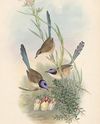Genus Malurus
Lovely Fairy-wren - Its natural habitats are subtropical or tropical dry forests and subtropical or tropical moist lowland forests.
Superb Fairywren - Like other fairywrens, the Superb Fairywren is notable for several peculiar behavioural characteristics; the birds are socially monogamous and sexually promiscuous, meaning that although they form pairs between one male and one female, each partner will mate with other individuals and even assist in raising the young from such pairings. Male wrens pluck yellow petals and display them to females as part of a courtship display.
Emperor Fairywren - The Broad-billed Fairywren is a species of bird in the Maluridae family. It is found in Indonesia and Papua New Guinea.
Red-winged Fairy-wren - Bearing a narrow pointed bill adapted for probing and catching insects, the Red-winged Fairywren is primarily insectivorous; it forages and lives in the shelter of scrubby vegetation in temperate wetter forests dominated by the Karri , remaining close to cover to avoid predators. Like other fairywrens, it is a cooperative breeding species, with small groups of birds maintaining and defending small territories year-round. Groups consist of a socially monogamous pair with several helper birds who assist in raising the young. There is a higher proportion of female helpers recorded for this species than for other species of fairywren. A variety of vocalisations and visual displays have been recorded for communication and courtship in this species. Singing is used to advertise territory, and birds can distinguish other individuals on song alone. Male wrens pluck yellow petals and display them to females as part of a courtship display.
Broad-billed Fairywren - The Broad-billed Fairywren is a species of bird in the Maluridae family. It is found in Indonesia and Papua New Guinea.
Variegated Fairy-wren - Like other fairywrens, the Variegated Fairywren is a cooperative breeding species, with small groups of birds maintaining and defending small territories year-round. Groups consist of a socially monogamous pair with several helper birds who assist in raising the young. Male wrens pluck yellow petals and display them to females as part of a courtship display. These birds are primarily insectivorous and forage and live in the shelter of scrubby vegetation across 90% of continental Australia, which is a wider range than that of any other fairywren.
White-winged Fairy-wren - The White-winged Fairywren mainly eats insects, supplementing this with small fruits and leaf buds. It occurs in heathland and arid scrubland, where low shrubs provide cover. Like other fairywrens, it is a cooperative breeding species, and small groups of birds maintain and defend territories year-round. Groups consist of a socially monogamous pair with several helper birds who assist in raising the young. These helpers are progeny that have attained sexual maturity but remain with the family group for one or more years after fledging. Although not yet confirmed genetically, the White-winged Fairywren may be promiscuous and assist in raising the young from other pairings. As part of a courtship display, the male wren plucks petals from flowers and displays them to female birds.
Red-backed Fairywren - The Red-backed Fairywren mainly eats insects, and supplements its diet with seed and small fruit. The preferred habitat is heathland and savannah, particularly where low shrubs and tall grasses provide cover. It can be nomadic in areas where there are frequent bushfires, although pairs or small groups of birds maintain and defend territories year-round in other parts of its range. Groups consist of a socially monogamous pair with one or more helper birds who assist in raising the young. These helpers are progeny that have attained sexual maturity yet remain with the family group for one or more years after fledging. The Red-backed Fairywren is sexually promiscuous, and each partner may mate with other individuals and even assist in raising the young from such pairings. Older males in breeding plumage are more likely to engage in this behaviour than are those breeding in eclipse plumage. As part of a courtship display, the male wren plucks red petals from flowers and displays them to females.
Blue-breasted Fairy-wren - Its natural habitat is Mediterranean-type shrubby vegetation.
Splendid Fairywren - Like other fairywrens, the Splendid Fairywren is notable for several peculiar behavioural characteristics; birds are socially monogamous and sexually promiscuous, meaning that although they form pairs between one male and one female, each partner will mate with other individuals and even assist in raising the young from such trysts.





